Dry fractionation, combining milling and air classification technology, offers an economical and sustainable pathway for the processing of value-added protein ingredients from Australia's major pulse crops. Leveraging a wider range of pulses will help meet the growing demand for plant-based protein ingredients. This study demonstrates the efficient processing of protein concentrates from Australian mungbean, which were characterized for key nutritional properties, phytochemical constituents, protein quality, and protein secondary structure.
Milling and air classification of mungbean flour resulted in protein concentrates (fine fraction) with a protein content of 62.2 g/100 g (db), reflecting a two-fold increase in protein content compared to the original flour (p < .05). Ash, fat, dietary fiber, and free phenolic and antioxidant compounds, also co-concentrated with protein in the fine fraction (p < .05), imparting enhanced nutritional properties with the potential to deliver health benefits. The protein quality of dry fractionated mungbean protein concentrate was compared to a commercial source of mungbean protein isolate (88 g/100 g, [db]). Amino acid scores highlighted deficiencies in sulfur-containing amino acids, methionine, and cysteine, as well as tryptophan and threonine. In vitro protein digestibility-corrected amino acid scores for the mungbean protein concentrate and protein isolate were 63.7% and 59.5%, respectively. SDS-PAGE protein profiles showed no major differences in protein composition, indicating that no specific types of proteins are lost during the dry fractionation process. Fourier transform infrared analysis of protein secondary structure showed that β-sheets were the dominant structural component, with relative percentages of 36% and 49%, for the mungbean protein concentrate and isolate, respectively.
There is significant potential for dry fractionation to deliver value-added opportunities for Australian mungbean, through the production of protein concentrate ingredients with enhanced nutritional properties for use in new and existing foods.
Nutritional properties, protein quality, and protein secondary structure were compared for protein concentrates and protein isolates processed from Australian-grown mungbean. Key findings from this study will inform pulse protein processors and pulse-based food manufacturers.



